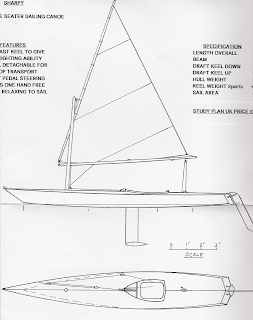




‘Sharpy’
‘Sharpy’ is a 15’ by 2’ 6” drop keel sailboat for a crew of one. I know of no other boat that can be transported on the top of a car, and yet is self-righting by the action of her keel. She’s like a decked, flat bottom canoe with a single chine. In effect, she’s a narrow sharpie. Her hull weight is only 85 lbs, and she has a lateen sail of 47 square feet. Derek Munnion, the designer of ‘Sharpy’, exhibited her at the Beale Boat Show where there was a fair amount of interest shown by visitors, including Gavin Atkin who has the excellent web log, http://intheboatshed.net/ . Gavin mentioned ‘Sharpy’ in an article at Duckworks Magazine describing exhibits at the Show. (See link below) I was exhibiting my ‘Micro’, along with boats owned by other members of the Dinghy Cruising Association, when I had the opportunity of seeing what was on offer at the Show, and I came across Derek’s ‘Sharpy’. I was impressed not only with the build quality, but with the concept - for here was a boat that did not require athleticism, agility or strength to sail. Any person, novice, experienced, young or old could manage ‘Sharpy’ without being anxious because she might capsize. Naturally, she will heel over in a gust, but because of her 80 lb keel she will right herself. There may be an occasion when self-preservation will cause her crew to judiciously release the mainsheet in a hurry to ensure water does not enter the cockpit, but Derek assures me he has only infrequently experienced water overlapping the side deck. She’s also a dry boat to sail.
There are no time-consuming operations that have to be done before getting afloat, such as having to assemble and attach outriggers, as would be the case with a Chesapeake CLC Kayak. A small wheel can be slotted onto the skeg for transporting the boat to the water’s edge. Her rig is set up, just by sliding the short mast into the support tube and leading the halyard and sheet through a couple of blocks. Then she is laid on her starboard side and her keel is inserted into the box, ready for attaching the port side half of the lead bulb, which locks into place with a retainer. The whole operation takes only a minute or so. The boat is then put in the water, and the rudder is attached. At that point she’s more or less ready to go. Make sure the keel is fully raised, get aboard, sit in the comfortable seat, adjust the foot steering bar (if necessary), and that’s it! Using a single-bladed paddle, make out into deeper water; fully drop the keel, hoist the sail, and you are off! The lateen sail is never reefed. If things get a bit lively, spill the excess wind from the sail by easing the sheet, or by luffing. When returning to the slipway, first drop the sail, then hoist the keel before using your paddle to take you there. Incidentally, the rudder is held down by a bungee, and it has no means of being lifted. Derek tells me it just raises up when it comes into contact with an obstruction such as a shelving beach. He has never had any problems in this respect.
Because the plans do not give details of the precise locations of every screw, nut and bolt, and because the metalwork for the making the keel and the hoisting mechanism may require the help of an experienced craftsman, Derek, advises that ‘Sharpy’ should be built by those who have the requisite skills. I would say, do not be put off by this, because building the hull and deck should not be difficult for anyone with basic woodworking skills. The other bits requiring engineering skills and specialist tools can be given to someone who is able to do it. ‘Sharpy’ is certainly on my shortlist of future projects.
Study Plans comprising three drawings, along with construction notes and details of materials required, can be obtained for £4.00, including postage worldwide. A full set of plans consisting of six A2 drawings and building instructions may be purchased for £40.00 – this includes postage within the UK. Add £3.00 for the USA, Europe and elsewhere.
For more information, contact Derek Munnion, Genula Cottage, 5, Catherine’s Walk, Andover, SP11 7AS. Telephone +44 (0)1264 711144
Please note that if you live in a country having a different time zone to the UK, be kind enough to phone Derek when he is likely to be awake! During office hours, might be best, alternatively send an email to: janmunnion@tiscali.co.uk
Notes
‘Sharpy’ was featured in Water Craft Magazine, number 37, published in 2003.
Links
Gavin Atkin’s Article
http://www.duckworksmagazine.com/02/articles/threemen/index.htm
CLC Kayak
http://www.clcboats.com/shop/boats/canoes/clc-sailrig-kayak-canoe-sailing-rig.html
Water Craft Magazine
http://www.watercraft.co.uk/
My ‘Micro’
http://bills-log.blogspot.com/2009/12/micro.html
1 comment:
I enjoy your blog. Did you finish your build of this canoe Bill? I would be interested in a further description of the sailing characteristics.
Post a Comment